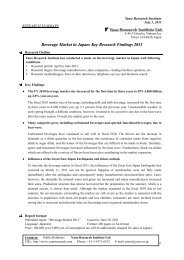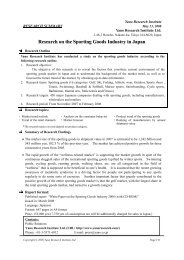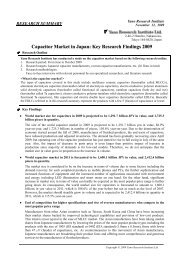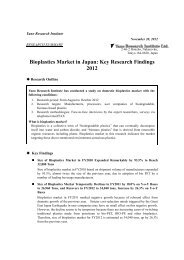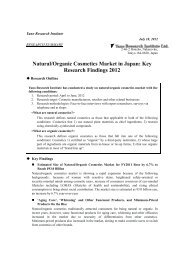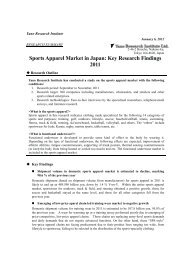Luxury Import Brand Market - Yano Research Home
Luxury Import Brand Market - Yano Research Home
Luxury Import Brand Market - Yano Research Home
You also want an ePaper? Increase the reach of your titles
YUMPU automatically turns print PDFs into web optimized ePapers that Google loves.
RESEARCH SUMMARYMay 19, 20102-46-2 Honcho, Nakano-ku,Tokyo 164-8620, Japan<strong>Luxury</strong> <strong>Import</strong> <strong>Brand</strong> <strong>Market</strong>: Key Findings 2010- Having shrunk down to considerably lower than 1 trillion yen level, the luxury import brandmarket is returning to its principle position. -<strong>Research</strong> Outline<strong>Yano</strong> <strong>Research</strong> Institute has conducted a study on the luxury import brand market as described below.1. <strong>Research</strong> period: February to May 20102. <strong>Research</strong> targets: Enterprises and trading companies engaged in the luxury import brand clothing andclothing merchandise business in Japan3. <strong>Research</strong> methodologies:Face-to-face interviews with relevant personnel and mail questionnaire survey, supplemented byinterviews via telephone and e-mail when relevant and effectiveIn this research, the luxury import brand market is defined to include major 10 item categories importeddirectly from Europe and the United States, consisting of “Ladies’ wear”, “Men’s wear”, “Babies’ wear”, “Bagsand leather items”, “Shoes and footwear”, “Ties”, “Scarves, shawls and handkerchiefs”, “Leather wear”,“Belts”, and “Gloves”.Key Findings♦ The 2009 <strong>Luxury</strong> <strong>Import</strong> <strong>Brand</strong> <strong>Market</strong> in Japan was 894.6 billion yen, decreased by 15.9% from theprevious year, the biggest drop it has ever experiencedThe size of the Japanese domestic luxury import brand clothing and general clothing merchandise market in2009 has shrunk down to the less than half of the market size in retail value peaked in 1996 (1,897.1 billionyen), back to the size in 20 years ago when the market was in an emerging stage.♦ Serious drop of “bags and leather items”, symbolic items for the popularization of luxury brands inJapanThe Lehman Shock in September 2008 has caused the rapid decline of “new wealthy class” grown in the“private investment boom”, and also led to the decrease of “middle to high income groups who have beendriving the “enthusiastic expenditure” in the market. These factors impacted the “bags and leather items”which account for the largest share of the luxury import brand market. Especially impacted were the“leather items” (such as wallet, key-holder, etc.) which are the entry items in the market, and the salesdropped rapidly.♦ From now on, “return to the principle position” will be a keyword for each luxury import band. Eachbrand, then, will develop their business in 5 market segments/directions, “Ultimate”, “Complete(traditional)”, “Accessible”, “Trendsetter”, and “Premium casual”.Although the luxury import brand market will be centered on “Complete (traditional)” segment with manyleading prestigious brands which have contributed to expanding the market in 90s, “Ultimate” focused onwealthy class and “Accessible” aimed for responding to new market trends are gaining their presence in themarket. Together with the other 2 segments, “Trendsetter” for high-end fashion and “Premium casual” forlifestyle/casual, a new genre being developed along with the growth of casual wear and items market, theluxury import band market will be segmented into 5 genres.Report format:Published report: “<strong>Luxury</strong> <strong>Import</strong> <strong>Brand</strong> <strong>Market</strong> in Japan 2010”Issued in: May 2010Language: JapaneseFormat: 452 pages in A4 formatPrice: 120,000 yen (6,000 yen of consumption tax shall be charged for the sales in Japan.)Contacts: Public Relations<strong>Yano</strong> <strong>Research</strong> Institute Ltd. (URL: http://www.yanoresearch.com)Phone: +81-3-5371-6912E-mail: press@yano.co.jpCopyright © 2010 <strong>Yano</strong> <strong>Research</strong> Institute Ltd. Page: 1/4
<strong>Research</strong> Summary1. <strong>Market</strong> overviewIn 2009, the luxury import brand market in Japan has experienced the greatest decline in its history, down to894.589 billion yen based on the retail price, which is 84.1% of the previous year, far exceeding the severemarket shrink by 10.2% in 2008. The market has decreased by 25% compared to the year before last. That isto say the market has lost one forth of its business, 290 billion yen in retail value in only 2 years.This fact may indicate how severely the luxury import brand market could be influenced by the economicconditions. Following 4 factors could be pointed out as the background and cause of the market shrink in the“worst 2 years”.1. The rapid decline of “new wealthy group” (private investors) grown in the finance, IT and privateinvestment bubbles prior to the Lehman Shock、coupled with greater impacts of the decrease of “middleto high income groups”, who have been the major customers of the market, and the rapid spread ofpurchase holding offs among them.2. Poor sales of the major product line in the market, “bags and leather items”, especially the entry itemsfor the mass audience such as “leather items (wallet, etc.)”3. Retail price reduction due to the “weak Euro” after the Lehman Shock4. Decrease of customers at the “department stores” which is the major sales channel of the market,coupled with the decreased number of baby boomer customers, a major customer segment, due to theprogress of their retirement in 2007 to 2009Among the above listed factors, most remarkable is the decrease of middle to high wage earning people whohad greatly contributed to popularizing the luxury import brands in recent years in Japan. The decrease inthese groups has led to the rapid decline of expenditure on “bags and leather items” which account for thegreatest portion of the market, especially the entry items, “leather items such as wallet, key-holder, etc.),leading to the shrinkage of the market in total. For “leather items (especially wallet)” and “belt”, there is agood demand for gifting in addition to personal use (purchase for own use). The gift demand also hasdrastically dropped due to the worsening business confidence in Japan.The changes in the foreign exchange market, from “strong Euro” in recent years to “weak Euro” happenedrapidly in 2009 had some impacts as well on the shrinkage of the market in retail value, as each brandlowered their retail price by 5 to 10 percent by adjusting to new exchange rate.In addition, the collective retirement of “baby boomers (born in 1947-1949)” accounted for a good portionof domestic expenditure, and major customers for the department stores as well had negative impacts on themarket as well.In the last 20 years, the market started booming in the 1990s with popularization focused on “small items”and “leather items”. Then, the enthusiasm began to cool down in 2000s, and the market expanded to“accessible” price zone to cover up the decline of enthusiasm. After having struggled through thetermination of “mass market”, the luxury import brand market is returning to its principle and properposition, including the size of the market. In the market environment as being described, it will be importantfor the individual brands to return to its original values and principles, and to have this fact clearlyunderstood by the future generations.In the global market, luxury bands market will still keep expanding centered on the emerging countries. Inthe Japanese market, however, the luxury import brands, especially the major brands which had beendriving the market, are being challenged if they could return to their principle position, in terms of “scale”as well as “content”, if they could overcome the conventional concept of “scale expansion” is the “businessdevelopment”, and implement major strategy transformation.Copyright © 2010 <strong>Yano</strong> <strong>Research</strong> Institute Ltd. Page: 2/4
Fig. 1: Transition of the <strong>Luxury</strong> <strong>Import</strong> <strong>Brand</strong> <strong>Market</strong>20,00018,97115,46416,61215,67415,00013,47713,31212,13712,578 12,207 12,051 11,695 11,877 11,85610,64310,0008,946 9,0285,000095 96 97 98 99 2000 01 02 03 04 05 06 07 08 09 10 (P)Note 1: Figures based on the retail pricesNote 2: Estimated based on CIF value reported in thetrade statistics and exchange rate in each yearNote 3: (P) indicates projection valueEstimated by <strong>Yano</strong> <strong>Research</strong> InstituteFig. 2: <strong>Luxury</strong> <strong>Import</strong> <strong>Brand</strong> <strong>Market</strong>, Distribution by ItemScarves, shawls,handkerchiefs2.8%Ties2.5%Leather wear1.2%Belts1.8%Gloves0.4%Ladies' wear20.7%Baby's wear0.1%Shoes, footwear14.1%Bags, leather items45.1%Men's wear11.2%Total: 894.589 billion yenNote 4: Based on the retail pricesEstimated by <strong>Yano</strong> <strong>Research</strong> InstituteCopyright © 2010 <strong>Yano</strong> <strong>Research</strong> Institute Ltd. Page: 3/4



